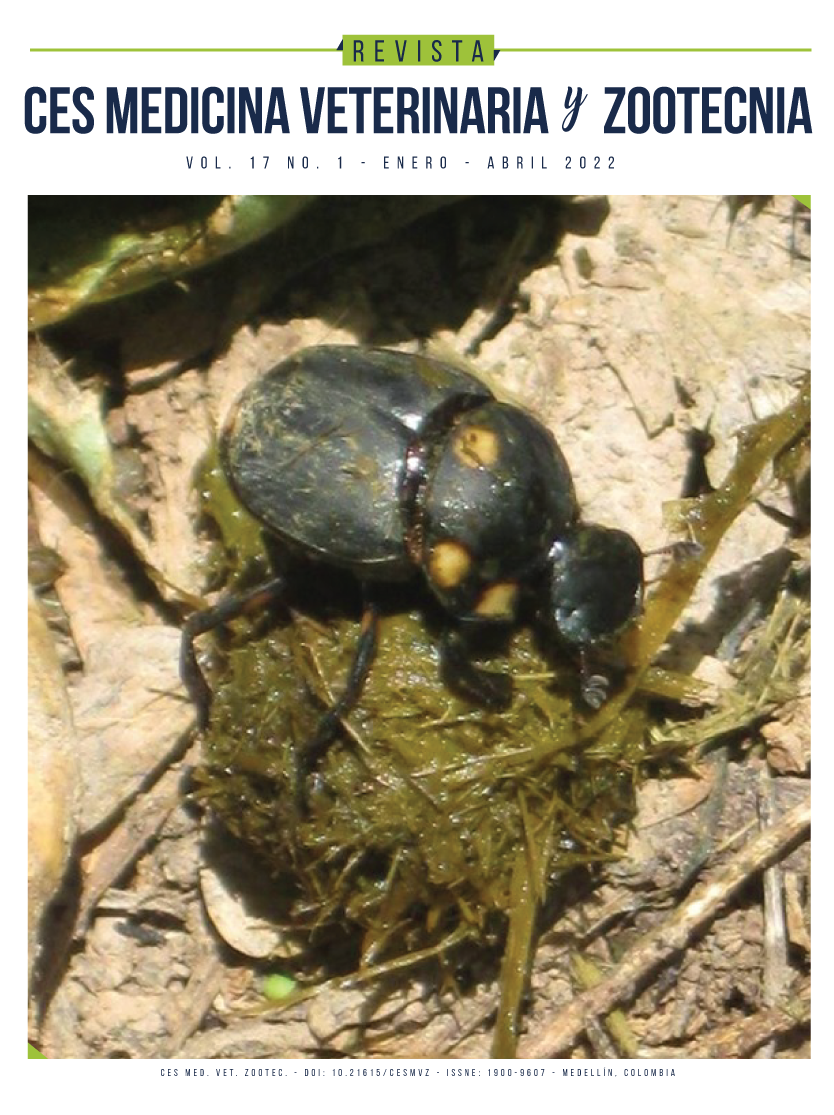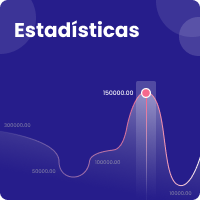Efectos colaterales del uso de la ivermectina en ganadería: comunidad de las boñigas en Colombia
DOI:
https://doi.org/10.21615/cesmvz.6591Palabras clave:
boñiga, escarabajos, Colombia, ivermectinaResumen
La ivermectina es el antiparasitario más usado en veterinaria a nivel mundial desde que entró al mercado en 1981. La U.S. Food and Drug Administration (FDA) americana en su valoración de riesgos determinó que, si bien es muy tóxica para organismos acuáticos, es improbable que, con las aplicaciones registradas para uso animal y por sus propiedades fisicoquímicas, se lleguen a contaminar cursos de agua. Sin embargo, los efectos de la ivermectina (IVM) sobre la fauna de invertebrados no blanco si pueden tener gran repercusión en la ecología de los pastizales por los costes asociados a la presencia de las boñigas no degradadas. De hecho, las pérdidas económicas por disminuir la calidad de los pastizales y reducir la superficie de los pastos disponible y apetecibles al ganado se han calculado en hasta 380 millones de dólares para la economía americana. La ivermectina afecta a un grupo muy beneficioso y diverso taxonómicamente que habita las boñigas, incluyendo a moscas coprófagas, avispas parasíticas, y escarabajos coprófagos y depredadores. Algunos estudios muestran que las boñigas de animales tratados con IVM pueden permanecer en los pastizales sin muestras apreciables de degradación hasta 340 días, mientras que las de animales no tratados son degradadas casi totalmente después de 80 días. Además, estudios de campo y laboratorio han mostrado que la sensibilidad de muchos insectos ocurre a concentraciones muy por debajo de las que se excretan con las heces de bovinos tratados con IVM. Los efectos sobre la reproducción y desarrollo de larvas de coleópteros ocurren incluso a concentraciones que son de hasta 10 veces por debajo de las que producen mortalidad. En Colombia se han identificado al menos 68 especies de la subfamilia Scarabaeinae que integran la comunidad de las boñigas del bovino. La mayor diversidad de escarabajos estercoleros se ha asociado a bosques y sistemas silvopastoriles que incorporan arboles nativos y proveen hábitats favorables para su supervivencia.
Descargas
Referencias bibliográficas
Arroyave Sierra OJ, Chamorro Rengifo J, Ochoa Muñoz AF (2019). Crecimiento de larvas de mosca soldado alimentadas con gallinaza, porcinaza y alimento para ponedoras. Revista Colombiana de Ciencia Animal, Recia, 2020; 11 (2): 73-81. https://doi.org/10.24188/recia.v11.n2.2019.730
Beynon SA, Peck M, Mann DJ, and Lewis OT. Consequences of alternative and conventional endoparasite control in cattle for dung-associated invertebrates and ecosystem functioning. Agriculture, Ecosystems and Environment 2012; 162: 36-44.
Bloom RA, Matheson JC. Environmental assessment of avermectins by the US Food and Drug Administration. Veterinary Parasitology 1993; 48:(1): 281-294.
Bueno LN, Santos RG, Guarín G, León G. Moscas de las frutas (Díptera: Tephritidae) y parasitoides asociados con Psidium guajava L. y Coffea arabica L. en tres municipios de la Provincia de Vélez (Santander, Colombia) Parte 2: Identificación y evaluación de parasitoides del Orden Hymenoptera. Ciencia & Tecnología Agropecuaria. 31 de octubre de 2004; 5 (1): 13-21.
Chaparro-Gutierrez JJ, Villar D, Schaeffer DJ, Interpretation of the larval immersion test with ivermectin in populations of the cattle tick Rhipicephalus (Boophilus) microplus from Colombian farms, Ticks Tick Borne Dis. 2020 Mar; 11 (2): 101323. doi: 10.1016/j.ttbdis.2019.101323.
Cook CW, Gerhardt RR. Selective Mortality of Insects in Manure from Cattle Fed Rabon® and Dimilin®. Environmental Entomology. Agosto de 1977; 6 (4): 589-90.
Crump A, Omura S. Ivermectin, Wonder drug from Japan: the human use perspective. Proc Jpn Acad Ser B Phys Biol Sci, 2011; 87 (2): 13-28. doi: 10.2183/pjab.87.13.
Cruz-Rosales M, Martinez I, Lopez-Collado J, Vargas-Mendoza M, Gonzales-Hernandez H, Fajersson P. Effect of ivermectin on the survival and fecundity of Euoniticellus intermedius (Coleoptera: Scarabaeidae). Rev Biol Trop 2012; 60 (1): 333-345.
Dadour I, Allen J. Control of bush flies by dung beetles. Department of Agriculture Farmnote Series: 1991 [Internet]. 2001 [citado 16 febrero 2020]. Disponible en: http://agspsrv34.agric.wa.gov.au/agency/pubns/farmnote/1991/F05891.htm
Davies IM, Mchenery JG, Rae GH. Environmental risk assessment from disolved ivermectin to marine organisms. Aquaculture 1997; 158 (3): 263-275.
Davies IM, Gillibrand PA, Mchenery JG. Environmental risk of ivermectin to sediment dwelling organisms. Aquaculture 1998; 163 (1):29-46.
Doube B, and Macqueen A. Establishment of exotic dung beetles in Queensland: the role of habitat specificity. BioControl, 1991; 36 (3): 353–360.
Fernández FC. Sistemática de los himenópteros de Colombia: estado del conocimiento y perspectivas. Proyecto Iberoamericano de Biogeografía y Entomología Sistemática 2000; ISBN 84-922495-1-X, páginas 233-243.
Floate KD. Off-target effects of ivermectin on insects and on dung degradation in southern Alberta, Canada. Bulletin of Entomological Research 1998; 88 (1): 25-35.
Floate KD. Endectocide use in cattle and fecal residues: environmental effects in Canada. The Canadian Journal of Veterinary Research 2006; 70 (1): 1-10.
Floate KD. Floate KD 2011. Arthropods in cattle dung on Canada’s grasslands. In: Floate KD ed. Arthropods of Canadian Grasslands (Volume 2): Inhabitants of a Changing Landscape. Ottawa: Biological Survey of Canada, 71-88. En 2011. p. 71-88.
Floate KD. et al. Validation of a standard field test method in four countries to asses the toxicity of residues in dung of cattle treated with veterinary medical products. Environ. Toxicol. Chem. 2015; 9999: 1-13. DOI: 10.1002/etc.3154.
Giraldo Echeverri C, Montoya Molina S, Escobar Sarria F. Escarabajos del estiércol en paisajes ganaderos de Colombia. 1.ª ed. Cali, Colombia: Fundación CIPAV.; 2018.
Giraldo-Echeverri C, Montoya-Lerma J, Escobar F, Chará J, Murgueitio E. Diversidad de escarabajos coprófagos en sistemas silvopastoriles del Valle del río Cesar, Colombia. 2015; 3er Congreso Nacional de Sistemas Silvopastoriles – VIII Congreso Internacional de Sistemas Silvopastoriles. 1ª ed. – Santa Cruz: Ediciones INTA.
González-Alvarado A, Torres E, Medina CA. Escarabajos coprófagos (Coleoptera: Scarabaeidae: Scarabaeinae) de bosques secos Colombianos de la Colección Entomológica del Instituto Alexander von Humboldt. Biota Colombiana, 2015; 16 (1): 88-95. doi:10.15468/hdfuql.
Halley BA, Jacob TA, Lu AYH. The environmental impact of the use of ivermectin: environmental effects and fate. Chemosphere 1989; 18 (7): 1543-1563.
Herd, R., Sams, R. & Ashcraft, S. Persistence of ivermectin in plasma and faeces following treatment of cows with ivermectin sustained-release, pour-on or injectable formulations’, International Journal for Parasitology 1996; 26 (10): 1087–1093. http://dx.doi.org/10.1016/S0020-7519(96)80007-5
Holter P. Food utilization of dung-eating Aphodius larvae. Oikos 1974; 25 (1): 71-79.
Horvat AJM, Babić S, Pavlović DM, Ašperger D, Pelko S, Kaštelan-Macan M, et al. Analysis, occurrence and fate of anthelmintics and their transformation products in the environment. TrAC Trends in Analytical Chemistry, 2012; 31(1): 61-84.
Jochmann R, Blanckenhorn WU. Non-target effects of ivermectin on trophic groups of the cow dung insect community replicated across an agricultural landscape Basic and Applied Ecology 2016; 17 (4): 291-299. https://doi.org/10.1016/j.baae.2016.01.001
Kruger K, and Scholtz CH. The effect of ivermectin on the development and reproduction of the dung-breeding fly Musca nevilli Kleynhans (Diptera, Muscidae). Agric. Ecosyst. Environ. 1995; 53 (1): 13–18.
Kruger K, Scholtz CH. Lethal and sublethal effects of ivermectin on the dung-breeding beetles Euoniticellus intermedius (Reiche) and Onitis Alexis Klug (Coleoptera, Scarabaeidae). Agric. Ecosyst. Environ. 1997; 61 (1): 123–31.
Liebig M, Alonso-Fernandez A, Blubaum-Gronau E, Brinke M, Carbonell G, Egeler P, Fenner K, Fernandez C. Environmental risk assessment of ivermectin: A case Study. Integr Environ Assess Manag 2010; 6 (Suppl.): 567-587. https://doi.org/10.1002/ieam.96
Lopez-Arias A, Villar D, Chaparro-Gutierrez J, Miller RJ, Perez de León AA. Reduced Efficacy of Commercial Acaricides Against Populations of Resistant Cattle Tick Rhipicephalus microplus from Two Municipalities of Antioquia, Colombia. Environmental Health Insights 2014: 8 (s2): 71–80 doi: 10.4137/EHi.s16006.
Losey JE, Vaughan M. "The Economic Value of Ecological Services Provided by Insects". BioScience., 2006;56(4): 11–23. doi:10.1641/0006-3568(2006)56[311:TEVOES]2.0.CO;2.
Lumaret JP, Galante E, Lumbreras C, Mena J, Bertrand M, Bernal JL. ‘Field effects of ivermectin residues on dung beetles’, Journal of Applied Ecology 1993; 30 (1): 428–436. http://dx.doi.org/10.2307/2404183
Martinez I, Lumaret JP, Ortiz Zayas R, Kadiri N. The effects of sublethal and lethal doses of ivermectin on the reproductive physiology and larval development of the dung beetle Euniticellus intermedius (Coleoptera: Scarabaeidae). The Canadian Entomologist 2017; 149 (4): 1-12. doi.org/10.4039/tce.2017.11.
Mendivil Nieto JA, Giraldo Echeverri C, Quevedo Vega CJ, Chará J, and Medina CA. Escarabajos estercoleros asociados a sistemas de ganadería sostenible en diferentes regiones de Colombia. Biota colombiana 2020; 21 (2): 134-141. https://doi.org/10.21068/c2020.v21n02a09
Moreno JCN. Escarabajos (Coleoptera: Scarabaeoidea) del departamento del Chocó, Colombia. Revista Biodiversidad Neotropical. 2011; 1 (1): 17-27. DOI:10.18636/bioneotropical.v1i1.25.
González-Rodríguez LM, García-Hernández AL, Clarkson B. First records of water scavenger beetle species (Coleoptera, Hydrophilidae) from Quindío Department, Colombia. Check List 2017; 13 (5): 605–620. https://doi.org/10.15560/13.5.605
Puerta JM, Chaparro JJ, Lope-Arias A, Arias-Arroyave S, Villar D. Loss of in vitro Efficacy of Topical Commercial Acaricides on Rhipicephalus microplus (Ixodida: Ixodidae) From Antioquian Farms, Colombia. Journal of Medical Entomology 2015; 52 (6): 1309-1314. https://doi.org/10.1093/jme/tjv129
Rodríguez LM, García-Hernández AL, Clarkson B (2017). First records of water scavenger beetle species (Coleoptera, Hydrophilidae) from Quindío Department, Colombia. Check List 13 (5): 605–620. https://doi.org/10.15560/13.5.605
Sommer C, Grønvold J, Holter P, Madsen M, Nansen P. Dung burial activity and development of ivermectin exposed Diastellopalpus quinquedens in a field experiment. Entomol. Exp. Appl., 1993a; 66 (1): 83–89.
Sommer C, Grønvold J, Holter P, Nansen P. Effects of ivermectin on two frotropical dung beetles, Onthophagus gazella and Diastellopalpus quinquedens (Coleoptera: Scarabaeidae). Vet. Parasitol. 1993b; 48 (1-4): 171–79.
Strong, L. and Wall, R. Ivermectin in cattle treatment: nonspecific effects on pastureland ecology. Aspects Appl. Biol. 1988; 17 (1): 231-238.
Strong L and James S. Some effects of rearing the yellow dung-fly, Scatophaga stercoraria, in cattle dung containing ivermectin. Entomol. Exp. Appl. 1992; 63 (1): 39–45.
Strong L, James S. Some effects of ivermectin on the yellow dung fly, Scatophaga stercoraria. Vet Parasitol 1993; 48 (1-4): 181–191.
Verdú JR, Cortez V, Martinez-Pinna J, Ortiz QJ, Lumaret JP, Lobo JM, Sánchez-Piñero F, Numa C. First assessment of the comparative toxicity of ivermectin and moxidectin in adult dung bettles: Sub-lethal symptoms and pre-lethal consequences. Nature Scientific Reports 2018; 8 (1): 14885. https://doi.org/10.1038/s41598-018-33241-0
Villar, D., Puerta, J., López A., & Chaparro, J. J. Ivermectin resistence of three Rhipicephalus microplus populations using the larval immersion test. Revista Colombiana de Ciencias Pecuarias, 2016a; 29 (1): 51–57.
Villar D, Gutiérrez J, Piedrahita D, Rodríguez-Durán A, Cortés-Vecino JA, Góngora-Orjuela A, Martínez N, Chaparro-Gutiérrez JJ. Resistencia in vitro a acaricidas tópicos de poblaciones de garrapatas Rhipicephalus (Boophilus) microplus provenientes de cuatro departamentos de Colombia. Rev. CES Med. Zootec. 2016b; 11 (3): 58-70.
Villar D, Klafke GM, Rodríguez-Duran A, Bossio F, Miller R, Perez-de-Leon AA, Cortes-Vecino JA, Chaparro-Gutierrez J. Resistance profile and molecular characterization of pyrethroid resistance in a Rhipicephalus microplus strain from Colombia. Medical and Veterinary Entomology 2020; 34 (1): 105-115. doi: 10.1111/mve.12418.
Wall R, Strong L. Environmental consequences of treating cattle with the antiparasitic drug ivermectin. Nature 1987; 327 (6121): 418-21. doi: 10.1038/327418a0.
Wohde M, Blanckenhorn WU, Floate KD, Lahr J, Lumaret JP, Rombke J. Analysis and dissipation of the antiparasitic agent ivermectin in cattle dung under different field conditions. Environmental Toxicology and Chemistry 2016; 35 (8): 1924-1933. doi.org/10.1002/etc.3462.
Descargas
Publicado
Cómo citar
Número
Sección
Licencia
Derechos de autor 2022 CES Medicina Veterinaria y Zootecnia

Esta obra está bajo una licencia internacional Creative Commons Atribución-NoComercial-CompartirIgual 4.0.
| Estadísticas de artículo | |
|---|---|
| Vistas de resúmenes | |
| Vistas de PDF | |
| Descargas de PDF | |
| Vistas de HTML | |
| Otras vistas | |



